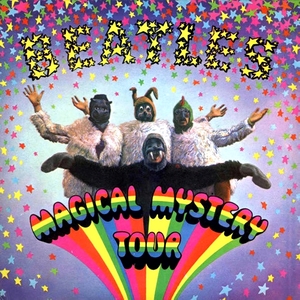
Magical Mystery Tour is a record by the English rock band the Beatles that was released as a double EP in the United Kingdom and an LP in the United States. It includes the soundtrack to the 1967 television film of the same name. The EP was issued in the UK on 8 December 1967 on the Parlophone label, while the Capitol Records LP release in the US and Canada occurred on 27 November and features an additional five songs that were originally released as singles that year. In 1976, Parlophone released the eleven-track LP in the UK.
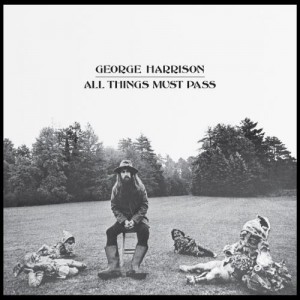
All Things Must Pass is the third studio album by the English rock musician George Harrison. Released as a triple album in November 1970, it was Harrison's first solo work after the break-up of the Beatles in April that year. It includes the hit singles "My Sweet Lord" and "What Is Life", as well as songs such as "Isn't It a Pity" and the title track that had been overlooked for inclusion on releases by the Beatles. The album reflects the influence of Harrison's musical activities with artists such as Bob Dylan, the Band, Delaney & Bonnie and Friends and Billy Preston during 1968–70, and his growth as an artist beyond his supporting role to former bandmates John Lennon and Paul McCartney. All Things Must Pass introduced Harrison's signature slide guitar sound and the spiritual themes present throughout his subsequent solo work. The original vinyl release consisted of two LPs of songs and a third disc of informal jams titled Apple Jam. Several commentators interpret Barry Feinstein's album cover photo, showing Harrison surrounded by four garden gnomes, as a statement on his independence from the Beatles.

Wonderwall Music is the debut solo album by the English musician George Harrison and the soundtrack to the 1968 film Wonderwall, directed by Joe Massot. Released in November 1968, it was the first solo album by a member of the Beatles, and the first album issued on the band's Apple record label. The songs are all instrumental pieces, except for occasional non-English language vocals, and mostly comprise short musical vignettes. Following his Indian-styled compositions for the Beatles since 1966, he used the film score to further promote Indian classical music by introducing rock audiences to instruments that were relatively little-known in the West – including shehnai, sarod, tar shehnai, tanpura and santoor. The Indian pieces are contrasted by Western musical selections, in the psychedelic rock, experimental, country and ragtime styles.
The discography of English singer-songwriter and former Beatle George Harrison consists of 12 studio albums, two live albums, four compilation albums, 35 singles, two video albums and four box sets. Harrison's first solo releases – the Wonderwall Music film soundtrack (1968) and Electronic Sound (1969) – were almost entirely instrumental works, issued during the last two years of the Beatles' career. Following the band's break-up in April 1970, Harrison continued to produce recordings by his fellow Apple Records acts, notably former bandmate Ringo Starr. He recorded and collaborated with a wide range of artists, including Shankar, Bob Dylan, Eric Clapton and Gary Wright.

"Savoy Truffle" is a song by the English rock band the Beatles from their 1968 album The Beatles. The song was written by George Harrison and inspired by his friend Eric Clapton's fondness for chocolate. The lyrics list the various flavours offered in Mackintosh's Good News chocolates and serve as a warning to Clapton about the detrimental effect that his gorging would have on his teeth. Along with Clapton's guest appearance on the White Album track "While My Guitar Gently Weeps" and Harrison reciprocating on Cream's "Badge", it is one of several songs that mark the start of a long-lasting musical association between the two guitarists.

"Blue Jay Way" is a song by the English rock band the Beatles. Written by George Harrison, it was released in 1967 on the group's Magical Mystery Tour EP and album. The song was named after a street in the Hollywood Hills of Los Angeles where Harrison stayed in August 1967, shortly before visiting the Haight-Ashbury district of San Francisco. The lyrics document Harrison's wait for music publicist Derek Taylor to find his way to Blue Jay Way through the fog-ridden hills, while Harrison struggled to stay awake after the flight from London to Los Angeles.
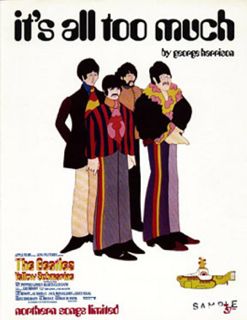
"It's All Too Much" is a song by the English rock band the Beatles from their 1969 album Yellow Submarine. Written by George Harrison in 1967, it conveys the ideological themes of that year's Summer of Love. The Beatles recorded the track in May 1967, a month after completing their album Sgt. Pepper's Lonely Hearts Club Band. It was one of four new songs they then supplied for the 1968 animated film Yellow Submarine, to meet their contractual obligations to United Artists.
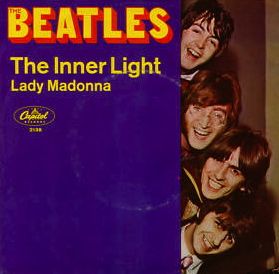
"The Inner Light" is a song by the English rock band the Beatles, written by George Harrison. It was released on a non-album single in March 1968, as the B-side to "Lady Madonna". The song was the first Harrison composition to be issued on a Beatles single and reflects the band's embrace of Transcendental Meditation, which they were studying in India under Maharishi Mahesh Yogi at the time of the single's release. After "Love You To" and "Within You Without You", it was the last of Harrison's three songs from the Beatles era that demonstrate an overt Indian classical influence and are styled as Indian pieces. The lyrics are a rendering of chapter 47 from the Taoist Tao Te Ching, which he set to music on the recommendation of Juan Mascaró, a Sanskrit scholar who had translated the passage in his 1958 book Lamps of Fire.

"All Things Must Pass" is a song by English rock musician George Harrison, issued in November 1970 as the title track to his triple album of the same name. Billy Preston released the song originally – as "All Things (Must) Pass" – on his Apple Records album Encouraging Words (1970) after the Beatles had rehearsed the song in January 1969 but did not include it on their Let It Be album. The composition reflects the influence of the Band's sound and communal music-making on Harrison, after he had spent time with the group in Woodstock, New York, in late 1968. In his lyrics, Harrison drew inspiration from Timothy Leary's poem "All Things Pass", a psychedelic adaptation of the Tao Te Ching.

Wonderwall is a 1968 British psychedelic film directed by Joe Massot and starring Jack MacGowran, Jane Birkin, Irene Handl, Richard Wattis and Iain Quarrier, with a cameo by Dutch collective the Fool, who were also set designers for the film.

The Remo Four were a 1950s–1960s rock band from Liverpool, England. They were contemporaries of The Beatles, and later had the same manager, Brian Epstein. Its members were Colin Manley, Phil Rogers, Don Andrew, and Roy Dyke (drums). Andrew and Manley were in the same class at school as Paul McCartney.
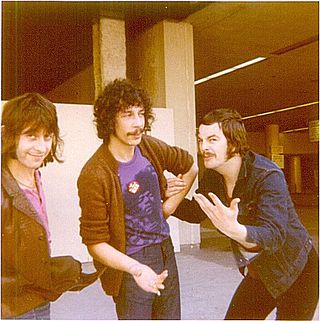
Ashton, Gardner and Dyke were a British rock trio, most popular in the early 1970s. They are best remembered for their song, "The Resurrection Shuffle", a transatlantic Top 40 one-hit wonder in 1971.
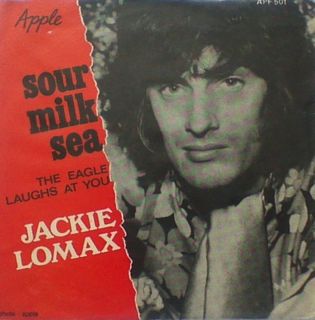
"Sour Milk Sea" is a song written by George Harrison and released by English rock singer Jackie Lomax as his debut single on the Beatles' Apple record label in August 1968. Harrison wrote the song during the Beatles' stay in Rishikesh, India and gave it to Lomax to help launch Apple Records. Lomax's recording is a rarity among non-Beatles songs since it features three members of the band – Harrison, who also produced the track, Ringo Starr and Paul McCartney. Performed in the hard rock style, the song also includes musical contributions from Eric Clapton and session pianist Nicky Hopkins. It was the first of many Harrison productions for artists signed to the Beatles' record label.

Edward Anthony Ashton was an English rock pianist, keyboardist, singer, composer, producer and artist.
Roy Dyke, is a rock drummer noted for his playing with The Remo Four, Badger, and Ashton, Gardner and Dyke.
John Barham is an English classical pianist, composer, arranger, producer and educator. He is best known for his orchestration of George Harrison albums such as All Things Must Pass (1970) and for his association with Indian sitar maestro Ravi Shankar.
"Dream Scene" is an experimental composition by English rock musician George Harrison. It was released in November 1968 on his debut solo album, Wonderwall Music, which was the soundtrack to the psychedelic film Wonderwall, directed by Joe Massot. The track is an instrumental piece, apart from occasional non-English language vocals and a spoken word segment. It comprises three sections and combines meditative Indian sounds and singing with passages of Western instrumentation and avant-garde styling, including backwards tape loops and sound effects. After viewing an early edit of Wonderwall at Twickenham Film Studios, Harrison devised the piece to accompany a psychedelic dream sequence in the film. The song serves as the narrative for the sequence, in which a strait-laced professor imagines himself duelling with the fashion photographer boyfriend of the young woman he obsessively spies on through a hole in the wall separating their apartments.

"Save the World" is a song by English rock musician George Harrison, released as the final track of his 1981 album Somewhere in England. It was also the B-side of "Teardrops", which was the second single off the album. An environmental protest song, "Save the World" was Harrison's first composition to directly address topical issues such as the nuclear arms race, rainforest and wildlife devastation, and the ecologically irresponsible practices of corporate concerns. Musically, the song partly recalls the style of the comedy troupe Monty Python.
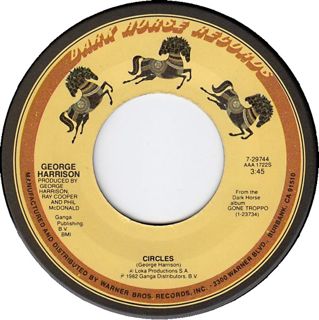
"Circles" is a song by the English rock musician George Harrison, released as the final track of his 1982 album Gone Troppo. Harrison wrote the song in India in 1968 while he and the Beatles were studying Transcendental Meditation with Maharishi Mahesh Yogi. The theme of the lyrics is reincarnation. The composition reflects the cyclical aspect of human existence as, according to Hindu doctrine, the soul continues to pass from one life to the next. Although the Beatles never formally recorded it, "Circles" was among the demos the group made at Harrison's Esher home, Kinfauns, in May 1968, while considering material for their double album The Beatles.














